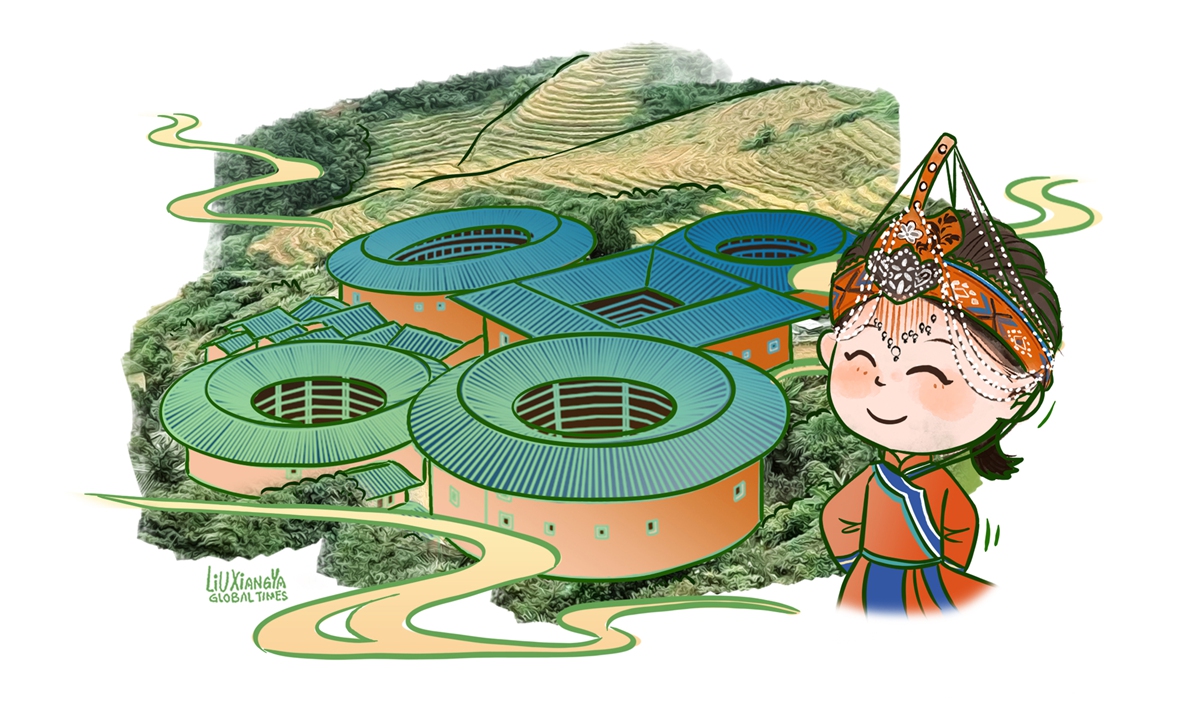
Illustration: Liu Xiangya/GT
As the bus wound up the mountain road, houses with traditional local features could be seen scattered across the land. Seeing rotating waterwheels in the river and farmers working in the field, the group of sinologists were awed by the beautiful pastoral scene during their bus trip to a tourist spot featuring the traditional buildings known as
tulou. Although the road up the mountain was winding, it was built to be smooth and level. Even the roadside lamps were designed in the shape of a
tulou, reflecting locals' attention to detail.
Traced back to the Song (960-1279) and Yuan (1279-1368) dynasties, Fujian
tulou is a type of Chinese rural dwelling used by the Hakka people in the mountainous areas in East China's Fujian Province. The large, enclosed and fortified earth buildings were inscribed on the UNESCO's World Heritage List in 2008.
"I remember before my first visit to Fujian more than a decade ago, I did not know much about Hakka culture. Chinese civilization is so diverse and inclusive," Slovenian sinologist Matej Zima told the Global Times while attending the Second World Conference of Sinologists that kicked off on Sunday in Nanping, Fujian Province.
Zima noted that instead of abandoning traditional culture, China's modernization and development have gone hand in hand with its cultural heritage, passing it on from generation to generation within the country and abroad.
After the opening ceremony, the sinologists went on trips to various places in Fujian Province. Some of them visited Zhangzhou's Nanjing county, where over 15,000
tulou buildings are preserved.
At the
tulou scenic area, the sinologists eagerly took videos with their phones of a tea art ceremony. Following the ceremony, local residents invited them to their homes for a short tour, sharing the stories about the interior design of the
tulou that had been handed down from their ancestors. There were also stalls and shops offering visitors the opportunity to dress in the attire of the local She ethnic minority for photos.
The ink rubbing workshop also gathered a crowd. The leader of the workshop guided the participants, showing them how to place a piece of red paper, a color symbolizing good luck and happiness in China, on a woodcut of a
tulou. After rolling the paper with golden ink, the participant got a beautiful picture of the
tulou, a unique souvenir made by their own hands that they could take home.
An elderly couple warmly greeted the sinologists, introducing various handmade
tulou models and offering freshly brewed local
jinxianlian tea. They noted that with the continuous improvement of infrastructure and local authorities' efforts to preserve cultural heritage, they have received many international visitors at their tiny shop. While this has benefited their small business, it has also given them the opportunity to make friends outside the small village where the couple has spent their entire lives.
In recent years, the Nanjing Tulou scenic area has boosted poverty alleviation efforts through tourism projects, with villagers actively planning and participating in targeted programs. Signs of eco-farms, rural inns and restaurants can be spotted across the village.
"China's civilization is like a river that keeps flowing. Unlike other ancient civilizations, it has never been interrupted," Abdel Aziz Hamdi, a sinologist and head of the Chinese language department at Al-Azhar University in Egypt, told the Global Times.
"China hasn't given up its traditional culture while advancing its social and technological development. That's what contributed to the Chinese civilization we see today, a combination of tradition and modernity," he said.
It is better to travel ten thousand miles than to read ten thousand books. As sinologists like Zima and Colin Mackerras pointed out, given the rapidly development of China, it is essential for sinologists to come to China and see China with their own eyes.
As the day drew to a close, the trip to the
tulou spot offered the sinologists the opportunity to gain a deeper understanding of Fujian's landscapes, traditions, and community life. This trip of blended tradition and progress, highlighted how culture can evolve while staying connected to its roots - a lesson the visitors would carry home and share worldwide.
The author is a reporter with the Global Times. life@globaltimes.com.cn




